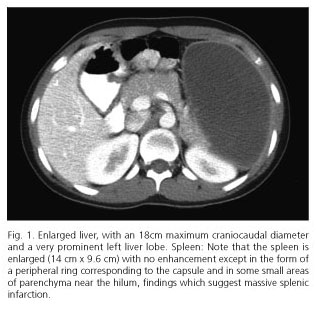Mi SciELO
Servicios Personalizados
Revista
Articulo
Indicadores
-
 Citado por SciELO
Citado por SciELO -
 Accesos
Accesos
Links relacionados
-
 Citado por Google
Citado por Google -
 Similares en
SciELO
Similares en
SciELO -
 Similares en Google
Similares en Google
Compartir
Revista Española de Enfermedades Digestivas
versión impresa ISSN 1130-0108
Rev. esp. enferm. dig. vol.106 no.4 Madrid abr. 2014
LETTERS TO THE EDITOR
Massive splenic infarction leading to sickle cell disease
Infarto esplénico masivo como debut de hemoglobinopatía S
Key words: Massive splenic infarction. Splenic abscess. Sickle cell disease.
Palabras clave: Infarto esplénico masivo. Absceso esplénico. Hemoglobinopatías.
Dear Editor,
We report the case of a female patient diagnosed with sickle cell disease following a massive splenic infarct.
Case report
A 26-year-old woman from Ecuador reported episodes of abdominal pain accompanied by anaemia, always in high-altitude places. At an altitude of 2,000 metres she began to feel general discomfort, nausea and pain in the left hypochondrium and was diagnosed with autoimmune haemolytic anaemia. Three months later, she was admitted to the emergency department of our hospital with a temperature of 38.6 oC, dysuria and pollakiuria. Her abdomen was soft on exploration and she had a painful splenomegaly of some 5 cm. The following tests were done:
- Computed axial tomography of the abdomen with oral and i.v. contrast (Fig. 1): Splenomegaly with massive splenic infarction. There were no vascular alterations to justify it.
- Blood test: Leukocytes 16,900 (82 % PMN), haemoglobin 11.5 g/dl, MCV 84, RDW 18, platelets 524,000.
- Urine: Positive nitrites, leukocytes 5-10/ field, erythrocytes 0-5/ field.
- Peripheral blood smears: Marked anisopoikilocytosis, abundant dianocytes and sickled red blood cells.
- Haemoglobin electrophoresis: Hb A2: 4 %, Hb F: 0 %, Hb S: 41 %, Hb C: 36 %.
She was consequently diagnosed with haemoglobinopathy S and C, with haemolytic crises and massive splenic infarction in the context of an acute pyelonephritis. Once the episode of acute pyelonephritis was resolved she was discharged for Haematology follow-up.
Two weeks later the patient was readmitted for a pain in the left hypochondrium and a temperature of 38 oC. Abdominal ultrasound revealed massive splenic infarction with probable superinfection. Emergency surgery was decided upon for superinfected massive splenic infarction, and a large-sized spleen was found adhering to the left liver lobe, stomach, pancreatic body and tail and abdominal wall, with old dark haematic content. A regulated splenectomy was performed. During the postoperative period she developed a collection at the surgical site and a low-debit pancreatic fistula, which were resolved with radiological drainage and octeotride. The histopathological study of the surgical specimen revealed a massively necrotic splenic parenchyma with large areas of abscessification.
Discussion
Sickle cell disease is an autosomal recessive hereditary disease characterised by the presence of Haemoglobin S (HbS) (1), which when deoxygenated is less soluble and polymerises, giving rise to sickled red blood cells or drepanocytes, which become rigid and join with other red blood cells to cause vascular occlusion (2,3).
The hypoxia caused when climbing to altitudes above 2,500 m may trigger vaso-occlusive processes and give rise to infarction, the most common of which is splenic (2,4). Other precipitating factors are the postoperative period, postpartum, salmonella sepsis and strenuous exercise (5,6).
Clinical features appear suddenly and progressively, beginning with abdominal pain in the left hypochondrium, general discomfort, fever and nausea, symptoms which may cause confusion with acute mountain sickness (2).
Ultrasonography and computed axial tomography diagnose splenic infarction, and electrophoresis of the red cell haemolysis enables the haemoglobinopathy to be typified.
Initial treatment for splenic infarction must be conservative, aimed at correcting the precipitating factors and achieving an adequate oxygenation and hydration. Surgical treatment will only be necessary in the presence of complications (haemorrhage, abscess or pseudocyst) and in massive infarction when symptoms persist (7-9).
Initial management of cases of splenic abscess is with antibiotics and percutaneous radiological drainage; a splenectomy is indicated if this fails or it is multilocular (10).
Mónica Mengual-Ballester, Enrique Pellicer-Franco, Bruno de Andrés-García and José Luis Aguayo-Albasini
Servicio de Cirugía General y Digestivo. Hospital General Universitario "JM Morales Meseguer".
Campus de Excelencia Internacional "Mare Nostrum". Universidad de Murcia. Murcia, Spain
References
1. Stuart MJ, Nagel RL. Sickle-cell disease. Lancet 2004;364:1343-60. [ Links ]
2. Frisancho OE, Ichiyanagui Rodríguez C. Infarto de bazo y hemoglobinopatía S en la altura. Rev Gastroenterol Perú 2012;32:68-78. [ Links ]
3. Samuel RE, Salmon ED, Briehl RW. Nucleation and growth of fibres and gel formation in sickle cell haemoglobin. Nature 1990;345:833-5. [ Links ]
4. Sullivan BH. Danger of airplane flight to persons with sicklemia. Ann Int Med 1950;32:338-40. [ Links ]
5. Jama AH, Salem AH, Dabbous IA. Massive splenic infarction in Saudi patients with sickle cell anemia: A unique manifestation. Am J Hematol 2002;69:205-9. [ Links ]
6. Al-Salem AH. Indications and complications of splenectomy for children with sickle cell disease. J Pediatr Surg 2006;41:1909-15. [ Links ]
7. Mahesh B, Muwanga CL. Splenic infarct: a rare cause of spontaneous rupture leading to massive haemoperitoneum. ANZ J Surg 2004;74:1030-2. [ Links ]
8. Al-Salem AH. Massive splenic infarction in children with sickle cell anemia and the role of splenectomy. Pediatr Surg Int 2013;29:281-5. [ Links ]
9. Chacaltana A, Rauch E, Morales J, Monge V, García P, Chávez P. Dolor abdominal agudo como manifestación de hemoglobinopatía estructural heterocigota (rasgo falciforme o sickle trait). Rev Esp Enferm Dig 2004;7:36-8. [ Links ]
10. Sreekar H, Saraf V, Pangi AC, Sreeharsha H, Reddy R, Kamat G. A retrospective study of 75 cases of splenic abscess. Indian J Surg 2011;73:398-402. [ Links ]











 texto en
texto en 



